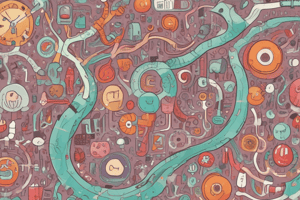Podcast
Questions and Answers
What is the main ionic form of ammonia at physiological pH?
What is the main ionic form of ammonia at physiological pH?
- Nitrate ion (NO3-)
- Ammonia (NH3)
- Nitric oxide (NO)
- Ammonium ion (NH4+) (correct)
Mammals assimilate most of their nitrogen from free ammonia.
Mammals assimilate most of their nitrogen from free ammonia.
False (B)
What reaction catalyzed by glutamine synthetase is critical for ammonia assimilation?
What reaction catalyzed by glutamine synthetase is critical for ammonia assimilation?
Formation of glutamine from glutamate and ammonia
The incorporation of ammonia into glutamate is facilitated by the enzyme __________.
The incorporation of ammonia into glutamate is facilitated by the enzyme __________.
Match the following enzymes with their functions regarding ammonia assimilation:
Match the following enzymes with their functions regarding ammonia assimilation:
What is transamination primarily responsible for?
What is transamination primarily responsible for?
All transamination reactions are catalyzed by the same enzyme.
All transamination reactions are catalyzed by the same enzyme.
Which enzyme is dependent on pyridoxal phosphate for transamination reactions?
Which enzyme is dependent on pyridoxal phosphate for transamination reactions?
The amino group of __________ can be transferred to many α-keto acids.
The amino group of __________ can be transferred to many α-keto acids.
Which of the following reactions produces ammonia?
Which of the following reactions produces ammonia?
Match the enzyme with the reaction it catalyzes:
Match the enzyme with the reaction it catalyzes:
L-amino acids are the form primarily used by enzyme systems in the body.
L-amino acids are the form primarily used by enzyme systems in the body.
What determines the direction of transamination reactions in vivo?
What determines the direction of transamination reactions in vivo?
What form of nitrogen is primarily excreted by aquatic animals?
What form of nitrogen is primarily excreted by aquatic animals?
Birds primarily excrete nitrogen as urea.
Birds primarily excrete nitrogen as urea.
What are the two major sources of nitrogen needed for amino acids?
What are the two major sources of nitrogen needed for amino acids?
N2 must be reduced to ______ to be used in amino acid metabolism.
N2 must be reduced to ______ to be used in amino acid metabolism.
Match the nitrogen-containing substances with their processes:
Match the nitrogen-containing substances with their processes:
Which enzyme is crucial for the conversion of nitrogen gas to ammonia?
Which enzyme is crucial for the conversion of nitrogen gas to ammonia?
Half of all biological nitrogen fixation occurs in the ocean.
Half of all biological nitrogen fixation occurs in the ocean.
What is the process called that oxidizes ammonia to nitrate?
What is the process called that oxidizes ammonia to nitrate?
The nitrogen cycle involves the flow of nitrogen from N2 to ______ and back to N2.
The nitrogen cycle involves the flow of nitrogen from N2 to ______ and back to N2.
Which of the following processes occurs during a lightning storm?
Which of the following processes occurs during a lightning storm?
What is the primary function of transaminases in amino acid metabolism?
What is the primary function of transaminases in amino acid metabolism?
All amino acids can undergo transamination reactions.
All amino acids can undergo transamination reactions.
What enzyme facilitates the removal of amino groups from amino acids to produce ammonia?
What enzyme facilitates the removal of amino groups from amino acids to produce ammonia?
The transfer of an amino group to a keto acid forms a new amino acid through __________ reactions.
The transfer of an amino group to a keto acid forms a new amino acid through __________ reactions.
Match the enzymes with their respective roles in amino acid metabolism:
Match the enzymes with their respective roles in amino acid metabolism:
Which of the following amino acids can lose its amino group to produce ammonia?
Which of the following amino acids can lose its amino group to produce ammonia?
Pyridoxal phosphate is not required for any transamination reactions.
Pyridoxal phosphate is not required for any transamination reactions.
What is the primary source of nitrogen for mammals?
What is the primary source of nitrogen for mammals?
The process of deamination primarily releases ammonia from amino acids.
The process of deamination primarily releases ammonia from amino acids.
What enzyme catalyzes the formation of glutamine from glutamate and ammonia?
What enzyme catalyzes the formation of glutamine from glutamate and ammonia?
Ammonia is often incorporated into low molecular weight metabolites via the amino acids _______ and _______.
Ammonia is often incorporated into low molecular weight metabolites via the amino acids _______ and _______.
Match the following processes with their corresponding enzymes:
Match the following processes with their corresponding enzymes:
Which of the following forms of nitrogen is primarily incorporated into amino acids in mammals?
Which of the following forms of nitrogen is primarily incorporated into amino acids in mammals?
All glutamate hydrogenases in organisms are specific for NADH only.
All glutamate hydrogenases in organisms are specific for NADH only.
What is a key pathway for incorporating ammonia into amino acid metabolism?
What is a key pathway for incorporating ammonia into amino acid metabolism?
The main function of glutamate dehydrogenase is the degradation of amino acids and the release of _______.
The main function of glutamate dehydrogenase is the degradation of amino acids and the release of _______.
What is the main product of nitrogen fixation in bacteria?
What is the main product of nitrogen fixation in bacteria?
Nitrogen gas (N2) constitutes approximately 80% of the Earth's atmosphere.
Nitrogen gas (N2) constitutes approximately 80% of the Earth's atmosphere.
What term is used to describe the process by which ammonia is converted to nitrate?
What term is used to describe the process by which ammonia is converted to nitrate?
In order to be used in metabolism, N2 and NO3− must be reduced to __________.
In order to be used in metabolism, N2 and NO3− must be reduced to __________.
Match the following nitrogen processes with their descriptions:
Match the following nitrogen processes with their descriptions:
Which of the following organisms are primarily responsible for half of all biological nitrogen fixation?
Which of the following organisms are primarily responsible for half of all biological nitrogen fixation?
Ammonia is toxic to most living organisms and requires conversion to safer forms before excretion.
Ammonia is toxic to most living organisms and requires conversion to safer forms before excretion.
What is the role of nitrogenase in nitrogen fixation?
What is the role of nitrogenase in nitrogen fixation?
During a lightning storm, high voltage discharges catalyze the oxidation of N2 to __________.
During a lightning storm, high voltage discharges catalyze the oxidation of N2 to __________.
Flashcards are hidden until you start studying
Study Notes
Transamination
- The transfer of an amino group from one molecule to another
- Most amino acids are deaminated by transamination
- The amino group of glutamate can be transferred to many α-keto acids in reactions catalyzed by enzymes known as transaminases or aminotransferases
- All known transamination reactions require the enzyme pyridoxal phosphate
- The transaminases catalyse near-equilibrium reactions
- The direction in which the reactions proceed in vivo (flux) depends on the supply of substrates and the removal of products
Removal and Disposal of Amino Acid Nitrogen
- Hydrolysis of asparagine and glutamine by asparaginase and glutaminase yields aspartate and glutamate, respectively
- Pyridoxal-5-phosphate dependent dehydration of serine and threonine yields pyruvate and α-ketobutyrate, respectively, and ammonia
- Deamination of histidine by histidinase (histidine ammonia lyase) yields ammonia and urocanate
- The purine nucleotide cycle operates in muscle
- L and D amino oxidase reactions. The D amino acid oxidase is mainly found in the kidney
- The function of D amino acid oxidase may be to racemize D-amino acids to L-amino acids, which are the form used by enzyme systems in the body
- The reaction produces α-keto acid
- The amino group is added in L-configuration by L-aminotransferase in the body
- The sources of amino acids can be the diet or gut bacteria
Routes for disposal of the Nitrogen-containing waste products of amino acid metabolism
- Excreted in aquatic animals as ammonia
- Excreted in birds and reptiles as uric acid
The Nitrogen Cycle and Nitrogen Fixation
- The nitrogen needed for amino acids (and for the heterocyclic bases of nucleotides) comes from two major sources: nitrogen gas in the atmosphere and nitrates (NO3−) in soil and water
- Atmospheric N2, which constitutes about 80% of the atmosphere, is the ultimate source of biological nitrogen
- N2 and NO3− must be reduced to ammonia in order to be used in metabolism
- The ammonia produced is then incorporated into amino acids via glutamate, glutamine, and carbamoyl phosphate
- N2 is chemically unreactive due to the strength of the N≡N triple bond
- Some bacteria have a very specific, sophisticated enzyme called nitrogenase, that can catalyse the reduction of N2 to ammonia in a process called nitrogen fixation
- During lightning storms, high voltage discharges catalyse the oxidation of N2 to nitrate (NO3−) and nitrite (NO2−)
- Nitrogen is converted to ammonia for use in plant fertilizers by an energetically expensive industrial process that requires high temperature and pressure as well as special catalysts to drive the reduction of N2 by H2
- The flow of nitrogen from N2 to nitrogen oxides, ammonia, and nitrogenous biomolecules and then back to N2 is called the nitrogen cycle
- Most of the nitrogen shuttles between ammonia and nitrate
- Ammonia from decayed organisms is oxidized by soil bacteria to nitrate
- This formation of nitrate is called nitrification
- Some anaerobic bacteria can reduce nitrate to nitrite to N2 (denitrification)
- Bacteria are the only organisms capable of producing ammonia from atmospheric nitrogen
- Half of all biological nitrogen fixation is performed by various species of cyanobacteria in the ocean
- The other half comes from soil bacteria
Assimilation of Ammonia
- Ammonia is assimilated into a large number of low molecular weight metabolites
- often via the amino acids glutamate and glutamine
- At physiological pH the main ionic form of ammonia is the ammonium ion, NH4+
- The reductive amination of α-ketoglutarate to glutamate by glutamate dehydrogenase is one highly efficient route for the incorporation of ammonia into the central pathways of amino acid metabolism
Glutamate dehydrogenase in Mammals
- Mammals probably assimilate very little nitrogen as free ammonia because they get most of their nitrogen from amino acids and nucleotides in the diet
- The primary role of glutamate dehydrogenase in mammals is the degradation of amino acids and the release of NH4+
- Another reaction critical to the assimilation of ammonia in many organisms is the formation of glutamine from glutamate and ammonia
- This reaction is catalysed by glutamine synthetase
- The glutamate hydrogenases of some species or tissues are specific for NADH while others are specific for NADPH. Some can use either.
Transamination
- Transamination is the transfer of an amino group from one molecule to another.
- Most amino acids are deaminated by transamination.
- The amino group of glutamate can be transferred to many α-keto acids in reactions catalyzed by enzymes known as transaminases or aminotransferases.
- All known transamination reactions require pyridoxal phosphate.
- Transaminases catalyze near-equilibrium reactions.
- The direction of the reaction
in vivodepends on substrate supply and removal of products.
Removal and Disposal of Amino Acid Nitrogen
- Ammonia is produced by the body in reactions involving the hydrolysis of side-chain amides, dehydration of serine and threonine, and deamination of histidine.
- Ammonia is also produced from the purine nucleotide cycle and L and D amino oxidase reactions.
- D amino acid oxidase is primarily found in the kidneys.
- Excess nitrogen is excreted as ammonia in aquatic animals, uric acid in birds, and reptiles.
The Nitrogen Cycle and Nitrogen Fixation
- Nitrogen for amino acids and nucleotides comes from atmospheric nitrogen gas and nitrates in soil and water.
- Atmospheric nitrogen gas is the ultimate source of biological nitrogen.
- Only a few species of bacteria can metabolize or "fix" atmospheric nitrogen.
- N2 and NO3- must be reduced to ammonia to be used in metabolism.
- Ammonia is incorporated into amino acids through glutamate, glutamine, and carbamoyl phosphate.
- N2 is chemically unreactive because of 𝑁≡𝑁 triple bond.
- Nitrogenase is the specific enzyme that catalyzes N2 reduction to ammonia in nitrogen fixation.
- Lightning storms can also oxidize N2 to nitrate and nitrite.
- Nitrogen conversion to ammonia for fertilizers requires high temperatures, high pressure, and special catalysts.
- The flow of nitrogen from N2 to nitrogen oxides, ammonia, nitrogenous biomolecules, and back to N2 is called the nitrogen cycle.
- Most nitrogen shuttles between ammonia and nitrate.
- Ammonia is oxidized to nitrate by soil bacteria in nitrification.
- Anaerobic bacteria reduce nitrate to N2 in denitrification.
Assimilation of Ammonia
- Ammonia is assimilated into low molecular weight metabolites, often through the amino acids glutamate and glutamine.
- The ammonium ion (NH4+) is the major ionic form of ammonia at physiological pH.
- Glutamate dehydrogenase is a highly effective pathway for incorporating ammonia into amino acid metabolism.
Glutamate Dehydrogenase and Glutamine Synthetase
- Glutamate dehydrogenase primarily functions in mammal amino acid degradation and NH4+ release.
- The formation of glutamine from glutamate and ammonia is catalyzed by glutamine synthetase.
Importance of Glutamate Hydrogenase and Glutathione
- Glutamate dehydrogenase in some species and tissues is specific for NADH or NADPH, while others can use either.
- Glutathione regeneration is crucial for the transport of amino acids within cells.
Amino Acid Metabolism
- Amino acid metabolism is studied from the perspective of their carbon skeletons and their origins and fates.
Definitions
- Transamination is the transfer of an amino group from an amino acid to a keto acid, resulting in a new amino acid and keto acid.
- Deamination is the removal of the amino group as ammonia (NH3).
Studying That Suits You
Use AI to generate personalized quizzes and flashcards to suit your learning preferences.




